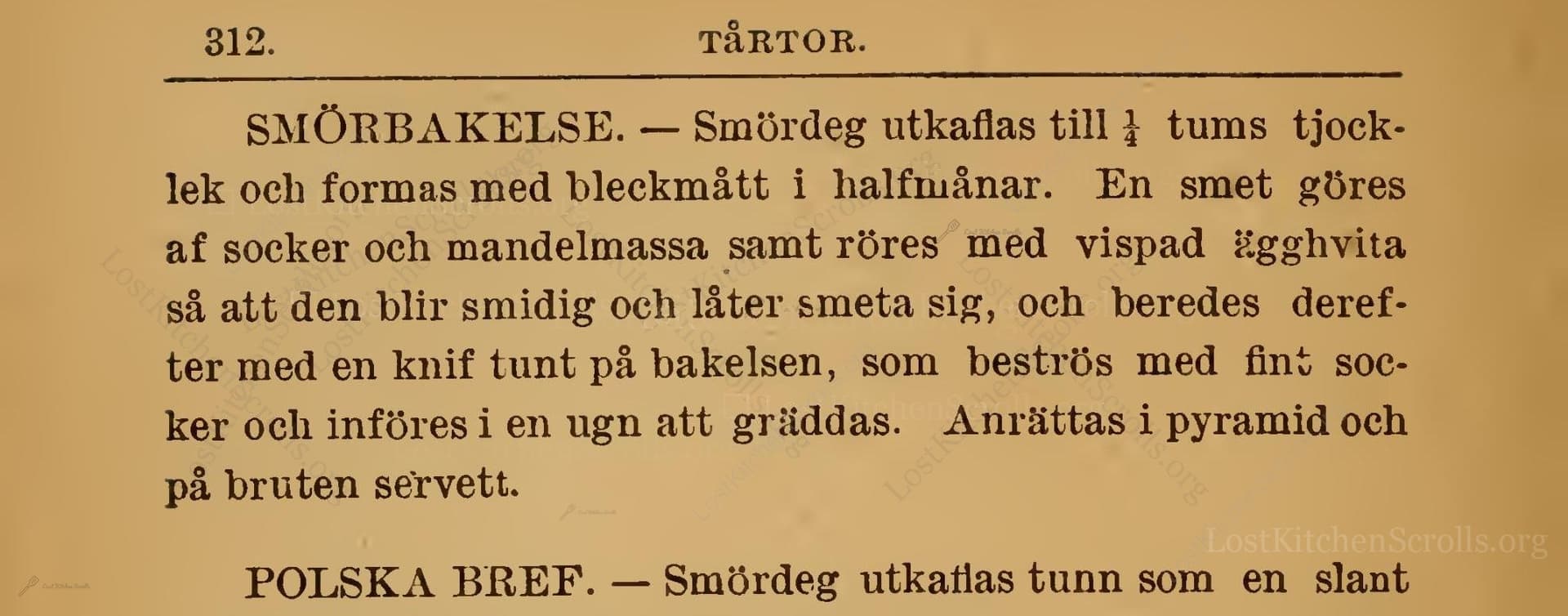Smörbakelse
"Butter Pastry"
From the treasured pages of Praktisk, illustrerad kok-bok för Svenskarne i Amerika
Written by C. A. (Charles A.) Vallentin

Smörbakelse
"Smördeg utkaflas till ¼ tums tjocklek och formas med bleckmått i halfmånar. En smet göres af socker och mandelmassa samt röres med vispad ägghvita så att den blir smidig och låter smeta sig, och beredes derefter med en knif tunt på bakelsen, som beströs med fint socker och införes i en ugn att gräddas. Anrättas i pyramid och på bruten servett."
English Translation
"BUTTER PASTRY — Puff pastry is rolled out to 1/4 inch thickness and shaped with a metal cutter into half-moons. A mixture is made of sugar and almond paste, which is stirred with beaten egg whites until it becomes smooth and spreadable, then thinly spread on the pastries with a knife. The pastries are sprinkled with fine sugar and placed in the oven to bake. Arrange in a pyramid on a folded napkin."
Note on the Original Text
The recipe is written in a concise, directive style common to late 19th-century Swedish cookbooks, assuming the reader possesses basic competency with both pastry and household management. Measurements and quantities are often implied rather than specified, and instructions focus on technique (rolling, shaping, spreading) rather than times or temperatures. Spelling, such as 'smördeg' (puff pastry) and 'äggghvita' (egg white), may vary from modern Swedish orthography. Instructions are brisk and presume familiarity with classic baking methods and the social rituals of serving, as seen in the final presentation on a folded serviette.

Title
Praktisk, illustrerad kok-bok för Svenskarne i Amerika (1889)
You can also click the book image above to peruse the original tome
Writer
C. A. (Charles A.) Vallentin
Era
1889
Publisher
Svenska bok-och musikhandelns förlag
Background
A practical and charmingly illustrated Swedish cookbook tailored for immigrants in America, this 1889 volume serves up a delightful array of recipes and culinary wisdom, blending Old World tradition with New World ingredients.
Kindly made available by
Library of Congress
This charming recipe comes from "Praktisk, illustrerad kok-bok för Svenskarne i Amerika," published in Minneapolis in 1889 for Swedish immigrants adjusting to life in the United States. The cookbook was designed to blend Swedish traditions with new-world ingredients and kitchen practices, allowing families to recreate a taste of home in an unfamiliar land. The recipe reflects a period when fancy pastries like smörbakelse (literally 'butter pastry') signaled festive occasions and gatherings, rooted in European baking traditions but made accessible within the vibrant Swedish-American communities of the Midwest.

Historically, home cooks would have used a heavy rolling pin to flatten the dough and tin or metal cutters to shape the half-moons. A sharp kitchen knife was employed to spread the almond filling precisely and thinly. To bake the pastries, a wood- or coal-fired oven was the norm. Serving involved a clean, crisp linen napkin folded artfully on a platter, forming an elegant base for arranging the baked goods in a striking pyramid, a typically decorative presentation of the era.
Prep Time
15 mins
Cook Time
20 mins
Servings
10
We've done our best to adapt this historical recipe for modern kitchens, but some details may still need refinement. We warmly welcome feedback from fellow cooks and culinary historians — your insights support the entire community!
Ingredients
- 9 oz ready-made or homemade puff pastry (smördeg)
- 2.5 oz almond paste (or substitute with marzipan if needed)
- 2.5 oz caster sugar
- 1 egg white (from a medium egg), beaten to stiff peaks
- Extra caster sugar for sprinkling
- Flour for dusting
Instructions
- Roll out puff pastry (smördeg) to about 1/4 inch thick on a lightly floured surface.
- Using a round cutter, cut out circles and then divide them in half to form half-moons.
- Prepare a filling by mixing equal parts of sugar and almond paste, then gradually stir in stiffly beaten egg white until the mixture forms a smooth, spreadable paste.
- Gently spread this filling thinly atop each pastry half-moon.
- Sprinkle the pastries generously with fine granulated sugar and place them on a parchment-lined baking sheet.
- Bake in a preheated oven at 400°F until golden and crisp, about 15–20 minutes.
- To serve, stack the cooled pastries in a pyramid shape atop a folded (bruten) napkin for an elegant presentation.
Estimated Calories
120 per serving
Cooking Estimates
It takes about 15 minutes to prepare the ingredients and assemble the pastries. Baking them in the oven takes another 15 to 20 minutes, until they turn golden and crispy. Each half-moon pastry has around 120 calories, and the recipe makes 10 servings.
As noted above, we have made our best effort to translate and adapt this historical recipe for modern kitchens, taking into account ingredients nowadays, cooking techniques, measurements, and so on. However, historical recipes often contain assumptions that require interpretation.
We'd love for anyone to help improve these adaptations. Community contributions are highly welcome. If you have suggestions, corrections, or cooking tips based on your experience with this recipe, please share them below.
Join the Discussion
Rate This Recipe

Den Bockfisch In Einer Fleisch Suppen Zu Kochen
This recipe hails from a German manuscript cookbook compiled in 1696, a time whe...

Die Grieß Nudlen Zumachen
This recipe comes from a rather mysterious manuscript cookbook, penned anonymous...

Ein Boudain
This recipe comes from an anonymous German-language manuscript cookbook from 169...

Ein Gesaltzen Citroni
This recipe, dating from 1696, comes from an extensive anonymous German cookbook...
Browse our complete collection of time-honored recipes



